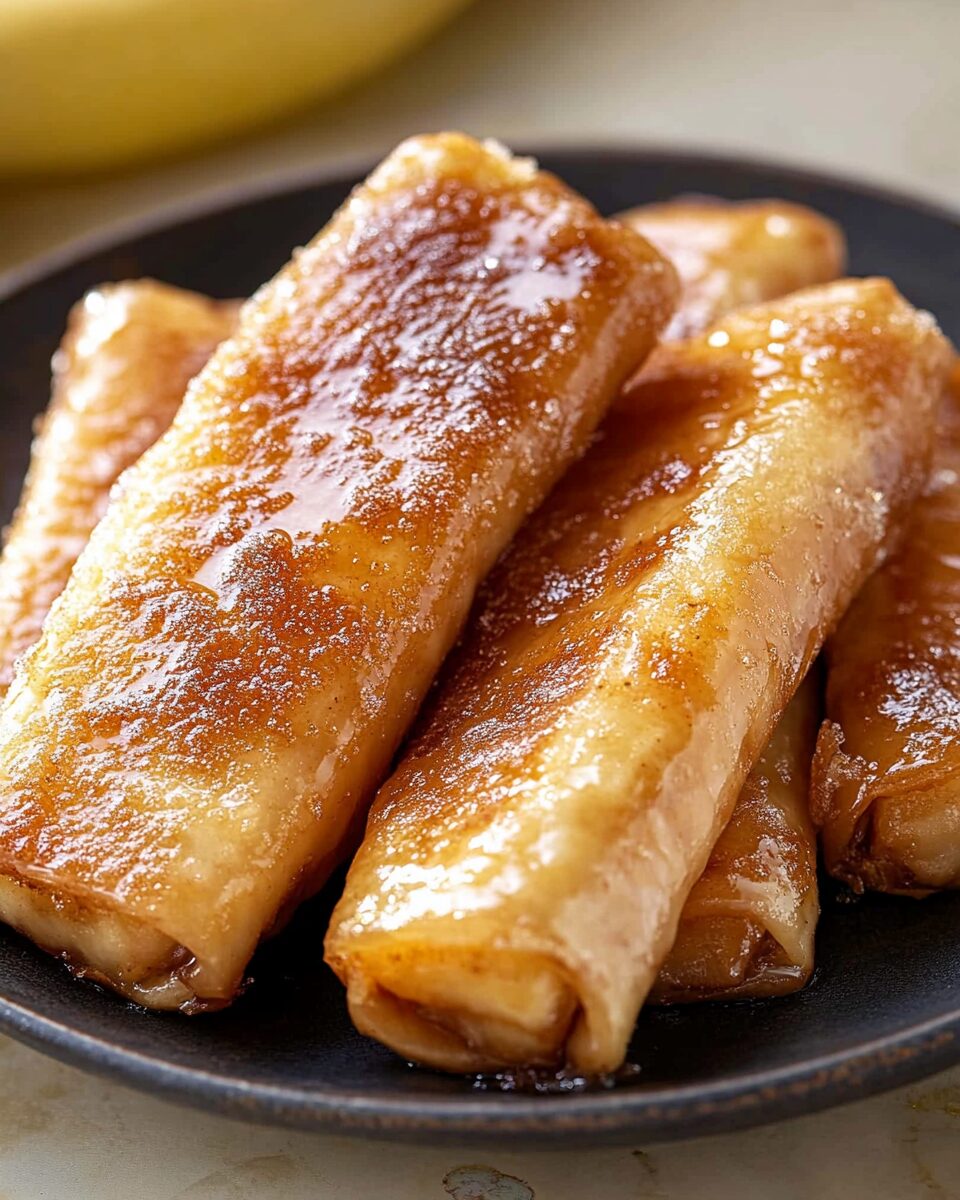Banana Turon is a beloved Filipino dessert made by wrapping ripe bananas and jackfruit in spring roll wrappers, then frying them to a golden crisp. It’s a delightful combination of crispy, caramelized exterior and soft, sweet fruit inside—perfect as a snack or after-meal treat.
FULL RECIPE
Ingredients
- 6 ripe saba bananas (or plantains), peeled and sliced lengthwise
- 1 cup ripe jackfruit, sliced into strips
- 12 spring roll wrappers
- 1 cup brown sugar
- Water (for sealing wrappers)
- Oil (for deep frying)
Directions
- Separate spring roll wrappers and lay one flat on a clean surface.
- Roll a banana slice in brown sugar until well coated.
- Place the sugared banana and a strip of jackfruit onto the wrapper.
- Fold the bottom edge over the fruit, fold in the sides, then roll tightly to form a log.
- Moisten the edge with water to seal the wrapper.
- Repeat with the remaining bananas and jackfruit.
- Heat oil in a pan over medium heat.
- Fry the turon in batches until golden brown and crispy, about 2–3 minutes per side.
- Drain on paper towels to remove excess oil.
- Serve warm for best texture and flavor.
Nutritional Information
- Calories: 180
- Total Fat: 6g
- Saturated Fat: 1g
- Carbohydrates: 34g
- Sugar: 20g
- Fiber: 2g
- Protein: 1g
- Sodium: 50mg
Cultural Significance of Banana Turon
Banana Turon, also known simply as “turon,” holds a special place in Filipino culture. It’s a popular street food and household snack that reflects the resourcefulness and creativity of Filipino cuisine. Often made with leftover saba bananas and jackfruit, it demonstrates how simple, readily available ingredients can be transformed into a delightful treat. It’s also commonly sold by vendors during school breaks, market days, and town fiestas, making it a nostalgic part of many Filipinos’ childhoods.
Origins of Turon in Filipino Cuisine
The exact origins of Turon are not fully documented, but it is widely believed to have evolved during the Spanish colonial period when the Philippines began incorporating various global influences into its culinary landscape. The wrapping and frying method likely came from Chinese culinary practices, while the concept of fruit-based desserts was influenced by Spanish tastes. Over time, this fusion developed into the unique dessert we know today.
Regional Variations of Turon
While the classic Turon features banana and jackfruit, regional variations abound throughout the Philippines. Some provinces include sweet potato, ube (purple yam), coconut strips, or even cheese. These additions not only provide new flavors and textures but also reflect the local ingredients available in different parts of the country, making Turon a versatile and adaptive dessert.
Turon as a Street Food Favorite
Banana Turon is a staple in the Philippine street food scene. It is typically found in small roadside stalls, local markets, or sold by roaming vendors. The aroma of frying Turon attracts passersby, and its affordability makes it an accessible snack for people of all ages. Its crispy exterior and sweet, gooey filling offer immediate satisfaction, making it a go-to merienda (afternoon snack) option.
Symbolism in Filipino Traditions
In Filipino traditions, Turon is often served during family gatherings, fiestas, and holiday celebrations. It symbolizes warmth, sharing, and home-cooked comfort. Many Filipinos associate Turon with family bonding moments, such as preparing the wrappers together or frying them in batches during a Sunday afternoon. It’s not just a snack but a representation of togetherness and heritage.
Nutritional Aspects of Turon
While Turon is undeniably delicious, it is also rich in carbohydrates and sugar, making it an energy-boosting snack. The bananas provide potassium and dietary fiber, while jackfruit contributes antioxidants and vitamin C. However, because it is deep-fried and often coated with sugar, moderation is key to enjoying it as part of a balanced diet.
Popularity Outside the Philippines
In recent years, Banana Turon has gained popularity outside the Philippines, especially in areas with large Filipino communities such as the United States, Canada, and the Middle East. Filipino restaurants and food trucks have introduced this dessert to a global audience, often putting creative spins on it to cater to diverse palates while preserving its traditional roots.
Pairing Ideas for Turon
Turon can be enjoyed on its own, but it also pairs beautifully with other dessert components. A scoop of vanilla or coconut ice cream can turn it into a more indulgent treat. Some even drizzle it with caramel or chocolate sauce for extra flavor. A hot cup of coffee or native Filipino tsokolate (thick hot chocolate) complements its sweetness and crispiness perfectly.
Making Turon Kid-Friendly
Turon is a great way to introduce children to Filipino flavors. Because it is sweet and easy to eat, kids are naturally drawn to it. Parents can also involve children in the preparation process, such as helping to wrap the bananas or roll them in sugar. This makes Turon not only a treat but a fun and interactive cooking experience for families.
Turon in Filipino Media and Pop Culture
Turon often appears in Filipino movies, TV shows, and social media content as a symbol of home-cooked goodness. It is featured in vlogs and food blogs, highlighting its status as a comfort food. Its presence in media reflects its deep cultural roots and its role as a culinary icon in Filipino society.
Tips for Perfectly Crispy Turon
Achieving the ideal crispy texture for Turon involves using the right amount of oil and maintaining the proper temperature while frying. Wrapping the turon tightly and ensuring the edges are sealed with water helps prevent oil from seeping in. Using brown sugar not only sweetens the filling but also caramelizes during frying, adding to the crunch.
Vegan and Healthier Alternatives
Health-conscious cooks have created vegan and lighter versions of Turon. These include air-fried turon, using coconut sugar instead of brown sugar, and incorporating whole wheat wrappers. While these versions may differ slightly in taste and texture, they offer a guilt-free way to enjoy this beloved snack.
Turon as a Fusion Dessert
Modern chefs have reimagined Turon by incorporating international ingredients. Variants include Turon with Nutella, peanut butter, or even mochi. These creative fusions keep the dessert fresh and exciting, appealing to new generations and non-Filipino food lovers curious about Southeast Asian cuisine.
Turon in Filipino Festivals and Celebrations
During large gatherings such as town fiestas, school events, or family reunions, Turon is often served alongside other Filipino delicacies. Its presence at these events underscores its role as a unifying dish, bringing people together through shared culinary experiences.
Storage and Reheating Tips
Turon is best eaten fresh, but leftovers can be stored in the refrigerator for up to two days. To reheat, using an oven or air fryer helps retain its crispness better than microwaving. Wrapping it loosely in foil while reheating can prevent it from getting soggy.
Commercial Production of Turon
Some Filipino entrepreneurs have taken Turon to the next level by producing it commercially. Pre-wrapped, frozen Turon is now available in supermarkets for easy at-home preparation. This innovation ensures the dessert’s availability year-round and supports local businesses.
Teaching Cultural Identity Through Food
For many Filipino families abroad, preparing and sharing Turon becomes a way to connect younger generations to their heritage. It serves as a delicious gateway to discussing family traditions, cultural values, and Filipino history in an engaging, memorable way.
Turon in Filipino School Lunchboxes
Turon often finds its way into Filipino school lunchboxes as a sweet treat or afternoon snack. Its portability, satisfying flavor, and simplicity make it a practical and comforting choice for parents packing meals for their children.
Turon for Special Diets
Though traditional Turon is not gluten-free or low-carb, modifications can be made to accommodate dietary restrictions. Using gluten-free wrappers and alternative sweeteners allows people with dietary needs to still enjoy this delicious Filipino dessert.
Conclusion
Banana Turon stands as more than just a dessert; it is a cultural emblem, a comfort food, and a symbol of Filipino ingenuity and warmth. From its humble beginnings as a street snack to its modern-day popularity worldwide, Turon continues to evolve while maintaining its cherished place in Filipino cuisine. Its crispy, caramelized exterior and sweet, tender filling offer a perfect balance of texture and flavor. Whether shared among family, sold at festivals, or enjoyed solo with coffee, Turon brings with it a sense of home, tradition, and simple joy.






